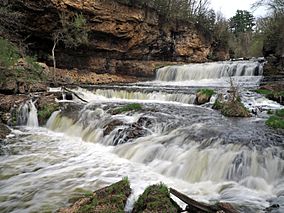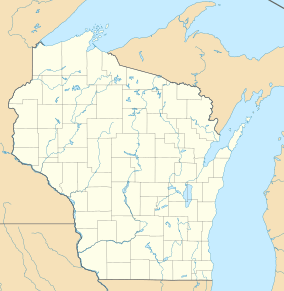Willow River State Park facts for kids
Quick facts for kids Willow River State Park |
|
|---|---|
|
IUCN Category III (Natural Monument)
|
|

Willow Falls
|
|
| Location | St. Croix, Wisconsin, United States |
| Area | 2,891 acres (11.70 km2) |
| Established | 1967 |
| Governing body | Wisconsin Department of Natural Resources |
Willow River State Park is a large park in Wisconsin, covering about 2,891-acre (1,170 ha) of land. It's located just five miles (8 km) north of Hudson. The most famous part of the park is Willow Falls, a powerful waterfall found in a deep gorge that is about 200-foot (61 m) deep.
Another popular spot is Little Falls Lake, which is a shallow lake on the Willow River. Many people visit Willow River State Park because it's close to the big cities of Minneapolis-St. Paul. Scientists have even found Trilobite fossils in the lower parts of the gorge, showing that the rocks here are around 600 million years old!
Contents
Park History: From Tribes to State Park
The land where Willow River State Park now stands has a long history. Long ago, the Santee Sioux and Ojibwe tribes lived in this area. They sometimes had conflicts over who had rights to the wild rice lakes. European explorers even saw one of their battles near the mouth of the Willow River in 1795.
As more people moved in by the 1830s, the Willow River Valley became busy with logging (cutting down trees) and wheat farming. The river was super important for logging because cut trees could be floated downstream to the St. Croix.
How Water Power Shaped the Park
A German immigrant named Christian Burkhardt saw that the river could also be used for farming. In 1868, he built a grist mill here, which used water power to grind grain into flour. Burkhardt became very rich and was always interested in new ways to use water power.
He even traveled back to Germany to study hydroelectric power plants, which use water to make electricity. In 1891, he returned and built his own power plant on the Willow River. Over time, Burkhardt built four power plants and dams on the river, which provided electricity to the city of Hudson.
Becoming a State Park
Later, in 1945, a company called Northern States Power bought Burkhardt's power company. They ran the plants until 1963, when one of the plants was damaged by a lightning strike. This made the company decide to sell their land along the Willow River.
In 1967, Northern States Power sold the land to the Wisconsin Conservation Commission, which wanted to create a state park. The company even helped fix the dams, even though it cost them money. Willow River State Park officially opened to the public in 1971. Some of the dams were removed in the 1990s to make the scenery even better and help the trout fish population. Today, only one dam remains. The park is still being restored from its past uses like damming and farming.
Fun Things to Do at Willow River State Park
Willow River State Park offers many exciting activities for visitors!
- Boating: You can launch your non-motorized boats, like canoes or kayaks, onto Little Falls Lake from the boat ramp.
- Camping: The park has a shaded campground with 72 campsites, and 19 of them have electricity. There are also 50 newer campsites in a natural prairie area, with 28 having electricity and 6 being pull-through sites for large RVs.
- Fishing: You can find both stocked and naturally reproducing trout throughout the Willow River, making it a great spot for fishing.
- Rock climbing: For adventurous climbers, there are several bolted sport climbs on the gorge walls. These climbs range in difficulty from easy to very challenging. The rock is a mix of limestone and dolomite.
- Climbing Rules: To keep everyone safe and protect the park, there are some rules. You cannot climb on Saturdays, or after noon on Fridays or Sundays. Also, you can't leave climbing gear permanently attached to the rocks, and rappelling (climbing down with ropes) from the very top of the gorge is not allowed.
- Swimming: There's a nice beach along the southern shore of Little Falls Lake. It has picnic tables, a beach house, and plenty of parking for a fun day of swimming.
Explore the Park's Trails
The park has many trails for hiking, biking, and even rollerblading!
- Hidden Ponds Nature Trail (hiking, accessible): This paved loop goes around a wetland and is easy to walk. It's about 0.6 miles (3,200 ft; 970 m) long. You can get guides at the start of the trail.
- Little Falls Trail (hiking, biking, rollerblading): This trail follows the developed shoreline from the campground to the dam. It's about 0.9 miles (4,800 ft; 1,400 m) long.
- Willow Falls Trail (hiking): This trail also follows the shoreline from the campground all the way to Willow Falls. It's about 0.9 miles (4,800 ft; 1,400 m) long.
- Willow Falls Hill Trail (hiking): If you want a quick way to the falls, this is a steep shortcut from a separate parking lot. It's only about 0.3 miles (1,600 ft; 480 m) long.
- Trout Brook Trail (hiking): This is a flat trail that goes along the river below the dam and back. It's about 1.1 miles (5,800 ft; 1,800 m) long.
- Oak Ridge Trail (hiking): This path goes through the forest between the lake parking area and the campground. It's about 0.9 miles (4,800 ft; 1,400 m) long.
- White Tail Trail (hiking): This loop branches off the Oak Ridge Trail and goes through forest meadows. It's a great place to spot white-tailed deer. It's about 1.6 miles (8,400 ft; 2,600 m) long.
- Knapweed Trail (hiking): This trail goes through fields that are being restored into beautiful prairie and forest areas. It's about 0.9 miles (4,800 ft; 1,400 m) long.
- Pioneer Trail (hiking): This trail leads past the gravesite of some of the first European settlers and offers a great view of Willow Falls. It's about 0.9 miles (4,800 ft; 1,400 m) long.
- Burkhardt Trail (hiking): This is a network of trails located above the falls, offering several amazing overlooks. It's about 3.0 miles (15,800 ft; 4,800 m) long.
- Mound Trail (hiking): This trail follows the Willow River in the wilder northeastern part of the park. You'll pass a glacial mound (a hill formed by glaciers). It's about 1.1 miles (5,800 ft; 1,800 m) long.
Willow River Nature Center: Learn About Nature!
The Willow River Nature Center is a fantastic place to learn about the plants and animals that live in the park. It's located near the main picnic area and has cool natural history exhibits. Park naturalists (experts on nature) also offer public programs throughout the year, so you can join in and learn even more!




